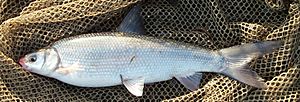Sacramento splittail facts for kids
Quick facts for kids Sacramento splittail |
|
|---|---|
 |
|
| Conservation status | |
| Scientific classification | |
| Synonyms | |
|
The splittail (Pogonichthys macrolepidotus), also known as the Sacramento splittail, is a type of carp fish. It lives in the low-lying waters of the Central Valley in California. A scientist named William O. Ayres first described this fish in 1854. The splittail is the only living fish in its group (genus). Another fish from the same group, the Clear Lake splittail, sadly died out in the 1970s.
The splittail gets its name from its unique tail fin. The top part of its tail is bigger than the bottom part. It also has tiny whiskers, called barbels, at the corners of its mouth. Its top fin has 9 to 10 rays, while its side fins have 16 to 19 rays. The fins on its belly have 8 to 9 rays, and the fin near its tail has 7 to 9 rays.
This fish is silver on its sides and a dark olive-gray on its back. When it's time to breed, its fins turn a reddish-orange color. Male splittails become darker and grow small white bumps on their heads and near their fins during this time.
Splittails mostly eat small creatures that live at the bottom of the water, along with dead plant and animal bits. They prefer areas where the water moves slowly or moderately. In places like Suisun Bay, they enjoy eating opossum shrimp, small amphipods, and copepods. In the Sacramento Delta, they eat clams, other small crustaceans, and insect larvae. When water levels are high, usually in February or March, splittails move into flooded areas to find earthworms. They use these flooded areas for both feeding and laying their eggs.
Where Splittails Live
Splittails live in the lower parts of the Central Valley, stretching all the way to San Francisco Bay. They used to be found as far north as Redding. However, they are now rarely seen in the upper Sacramento River. They were once caught in the southern San Francisco Bay and in Coyote Creek in Santa Clara County.
Today, their main homes are the Sacramento Delta, Suisun Bay, and the lower parts of the Sonoma Creek, Petaluma River, and Napa River. Splittails can handle water that is a bit salty or alkaline (the opposite of acidic).
Conservation Status
The splittail's protection status has changed over time. On September 22, 2003, the U.S. Fish and Wildlife Service changed its status from "threatened" to a "species of special concern." This change happened after a legal challenge.
The natural system of small waterways and flooded areas in the Central Valley, which the splittail depends on, has changed a lot. Scientists are still studying why the number of splittails has gone down. The IUCN (a global group that tracks endangered species) used to list the splittail as endangered. But in 2013, they changed its status to least concern. This means they are not currently at high risk of dying out.
See also
 In Spanish: Pogonichthys macrolepidotus para niños
In Spanish: Pogonichthys macrolepidotus para niños


